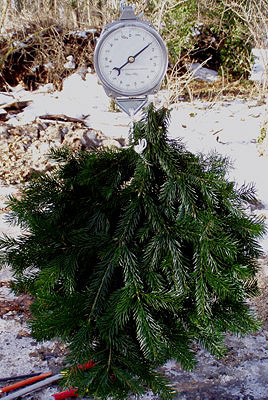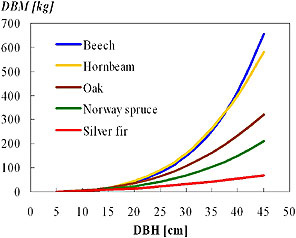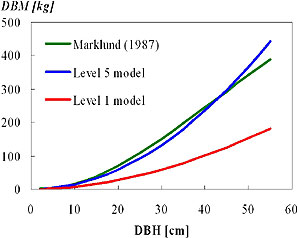
How much biomass do the tree compartments have?
Biomass equations for Austria
Currently, the topic "biomass" is a contemporary issue not only in Austria. On the one hand this is due to the report obligation to the annual greenhouse gas balance in context of the framework convention on climate change of the United Nations (UN-FCCC); On the other hand the supply of heating- and power-plants plays an important role. In Austria therefore a working group was concerned with the development of country-wide applicable biomass equations.
Supplements needed to fulfill report obligations
Up to now the report obligation was fulfilled by estimating the carbon (C) stock from the data of the Austrian National Forest Inventory (ANFI) using stem volume equations, tree-species-specific wood densities, biomass expansions factors, and the concentration of carbon. While the ANFI provides representative data of the Austrian forests, the applied biomass expansions factors came from biomass studies that are not representative for Austrian conditions. However, representative data would be needed to fulfill highest quality standards of reporting criteria within IPCC, which is obligatory if the forest contributes more than 10% to the greenhouse gas balance, as this is the case in Austria. Thus, it became necessary to develop biomass equations that are based on Austrian data, and which estimate the biomass of tree compartments other than stem wood.
Data, methods and results

Figure 1: Behaviour of the new biomass equations. Height/diameter ratio = 0.7, crown ratio = 0.3, crown width ratio = 0.5, age = 60 years.

Figure 1: Behaviour of the new biomass equations. Height/diameter ratio = 0.7, crown ratio = 0.3, crown width ratio = 0.5, age = 60 years.
Being part of the biomass working group, the Department of Forest Growth and Silviculture (BFW) could resort to a solid data base that originates from the long tradition in the establishment and management of long-term experimental plots. From 1920-1960, branch mass was determined from each tree that was removed from an experimental plot. This resulted in a data set that comprises five tree species with 8744 records of individual-tree based measurements of DBH, tree length, crown length, crown width, and branch mass. Because thinning from below was the preferred thinning regime in those times, most of the trees are characterized by a small DBH and a high height/diameter ratio, respectively. Based on these data we developed allometric relationships for Norway spruce (Picea abies (L.) KARST.), silver fir (Abies alba Mill.), beech (Fagus sylvatica L.), oak (Quercus spp.), and hornbeam (Carpinus betulus L.) For coniferous trees these biomass equations estimate the dry branch mass (DBM) including needle mass, but the estimates for broad-leafed trees do not include the mass of the leaves (Fig. 1).
The objective of this study was to develop biomass equations capable to predict DBM from routine inventory data. However, routine inventory data do not always provide those variables that would be needed for high reliable predictions. To overcome these difficulties we developed several models with a different degree of complexity (levels), beginning with the simplest model that predicts DBM solely from DBH (level 1). On the other hand the most complex model predicts DBM from DBH, height, crown length, crown width, and age. The results of this study indicate that special care is appropriate in the application of simple models which were developed from a specific and limited data-set (e.g. suppressed trees from thinning material). The results further show that the range of applicability of such models can be extended, if all important tree attributes, particularly crown parameters, are included in the models (Fig. 2).
Functions and model coefficients
The full paper including all functions and model coefficients as well as the results of all other members of the working group were published in a special issue of the Austrian Journal of Forest Science (www.forestscience.at) Vol. 123(1/2).
